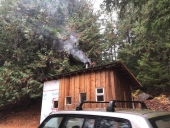
 4
4





 1
1




God of procrastination https://www.youtube.com/watch?v=q1EoT9sedqY

 2
2




For all your Montana Masonry Heater parts (also known as) Rocket Mass heater parts.
Visit me at
dragontechrmh.com Once you go brick you will never go back!
 1
1








Joshua Hozjan wrote:p.s. My living space (contains all the things) is 6ft high, 6ft wide, 12ft long. So I am pretty sure a RMH/S would be plenty and multipurpose-able.. I think?
As others wrote the ceramic blanket riser would work well. Tim Robertson used a thin cloth dipped in refractory or furnace cement instead of metal to hold the riser shape.Joshua Hozjan wrote:3. [...] Is the RMHS something I can contain in just a metal frame with say - the a ceramic fiber isolation method for the raiser to keep the weight down.
Joshua Hozjan wrote:4. Driving/bumps/vibrations. My suspension is pretty rad, but I fear for something like the RMH because most builds are brick/mortor/cod and with enough vibrations they will definitely shift and crack apart.. Is there a way I could avoid brick/mortor/cod entirely and use almost entirely ceramic fiber isolation and I guess steel/SS to keep it in place? I can weld and have a welder available. So something like a steel/SS box frame to weld all the pieces together and onto the frame. J firebox tube + raiser + manifold + chimney secured with welding or whatever works.








For all your Montana Masonry Heater parts (also known as) Rocket Mass heater parts.
Visit me at
dragontechrmh.com Once you go brick you will never go back!




thomas rubino wrote:The gravel filled bench has been used successfully but it is not the best of choice's.

thomas rubino wrote:Have you considered a half barrel system? They work very well and weight might be less than a gravel bench.
thomas rubino wrote:Any wood under a core unit is in danger of pyrolysis. The safest way to have a wood floor under a rmh is to raise the whole core unit up with flat bricks and cement board, then clay / perlite on that.
thomas rubino wrote:Your idea of the under floor vent sounds like it might be problomatical. Could work great , might work most of the time ... or might be a big pita to get drawing....
Konstantin Kirsch wrote:A RMH has minimum 2 pumps: First the heat riser pumpes the hot air up. Second the barrel pumpes the air down on heat exchange over the surface.
If you do have a vertical chimney than you have a third pump.
At my RMH I got the problem that the feed tube got very hot in time. After some hours of use the temperature rises up to 900 °F. A new wooden stick starts to burn on all sides and on the total length immediately after putting it into the feed tube. Than smoke comes into the room...
Now I added a fourth pump at my RMH: On cooling the feed tube the wood is only burning sideways at the bottom. There is no draft upways in the feed tube any more. There is no more smoke coming into the room. There is no probem anymore on closing the door quickly and there we got hot water!
I took the feed tube out of steel and added a thick plate out of steel to it
Than I put a put with cold water on top. he feed tube getts now cooled by the water and the water gets hotter.

Konstantin Kirsch wrote: but the waterpot has not enough water in it. I produce much more boiling water than needed. In the time the feed tube gets too hot even I cool it with this system. So I found that the cooling of the feed tube is very importand. I'm realy thinking of making an aktive water cooling system direct around the feed tube.
A J-shaped thermosiphon (such as our firebox) operates in a similar way as the reverse-J water siphon. The short leg is near the source of fuel and air. The flames follow the longer leg upward, creating a strong draft. [...] In addition to a difference in height and the absence of leaks, a thermosiphon also requires a consistent temperature or difference in temperatures. If the short leg became much hotter than the long one, the thermosiphon could stop working or even flow backwards.

|
You have to be odd to be #1 - Seuss. An odd little ad:
Learn Permaculture through a little hard work
https://wheaton-labs.com/bootcamp
|





